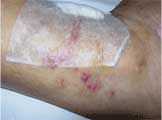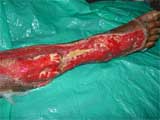Vasculitis is swelling (inflammation) of walls of blood vessels. Blood vessels are of 3 types - arteries (that carry blood from the heart to the periphery), veins (that bring blood from various organs back to the heart), and capillaries (small intervening vessels where exchange of gases and nutrients takes place). Blood vessels are spread all over our body and supply blood to every cell. Blood provides oxygen and various nutrients to these cells. Thus, blood vessels are important as their diseases lead to abnormal blood supply endangering the cells supplied by them.
An inflamed (swollen) blood vessel can narrow and close off or balloon out (aneurysm) and possibly rupture. Vasculitides (plural of vasculitis) is a group of various rare diseases that are autoimmune. The involved blood vessels can be large, medium, or small-sized. Any blood vessel or organ can be affected by vasculitis. Vasculitis can be localized or generalized (systemic). A particular type of vasculitis is usually restricted to vessels of a particular size. Most vasculitides affect the skin and do not cause dysfunction of internal organs. Some forms are short-lasting and innocuous, whereas many others are chronic and can be life-threatening. Relapses are common in certain types, and hence lifetime surveillance is advisable. Vasculitis can affect anyone though some forms are more common in certain groups of patients. Early diagnosis and expert management are essential for a successful outcome in these cases.
Causes
The exact cause of vasculitides is multifactorial (genes, gender, and environment) and is unknown. Secondary vasculitis is due to a known cause and appears in the course of other defined diseases. Treatment consists of control of the primary disease.
Some causes of secondary vasculitis are listed below:
- Infection - Viruses (Hepatitis B and C, HIV, Varicella zoster, etc.), bacteria (TB, gonorrhea, streptococci, staphylococci, etc.), fungi, and others (e.g., syphilis)
- Cancer - Most malignancies (solid organ tumors, lymphoma, and others)
- Drugs - Vaccines and desensitization agents, drugs used for nasal allergies (montelukast and others from this group), propylthiouracil, hydralazine, heroin, cocaine, amphetamine, etc. The vasculitides appear after prolonged exposure to the drug, are usually limited to the skin, and disappear on early withdrawal of the offending agent.
- Inflammatory connective tissue diseases - rheumatoid arthritis, systemic lupus erythematosus, Sjögren’s syndrome, and others
Some diseases can mimic vasculitis (pseudo-vasculitis) and need expert advice for a proper diagnosis. Infections (e.g., infective endocarditis), cancer (metastasis or paraneoplastic), scurvy (severe Vitamin C deficiency), embolism (myxoma in heart, infection, and cholesterol), thrombosis (Antiphospholipid antibody syndrome, calciphylaxis), and some other diseases may present as multiorgan illness, wrongly diagnosed as vasculitis.
Features
Fever, fatigue, malaise (feeling unwell), loss of appetite, and weight loss are general symptoms seen in most forms of vasculitis. Joint pains, non-deforming arthritis, muscle pains, numbness, and weakness also occur in some of these conditions. Symptoms usually last for a long time and may disappear and reappear.
Specific features of some common vasculitides in adults are tabulated below:
TypeSex
AgeFeature
| Type | Sex Age |
Feature |
|---|---|---|
| Takayasu’s Arteritis | 15-25 years Females (9:1) | Cramping pain in arms or legs on use (claudication), low pulse volume, headache, visual disturbances |
| Giant Cell Arteritis | More than 50 years Females (3:1) |
headache, jaw claudication while chewing, blurred or double vision (may cause blindness), scalp tenderness, weakness, and pain of shoulder girdle and hips (associated polymyalgia rheumatica) |
| Polyarteritis Nodosa (Can be associated with Hepatitis B) |
40-60 years Males (2:1) |
Weight loss, high blood pressure, clustered nodules on skin, net-like(reticular) purplish discoloration of the skin (livedo), weakness due to involvement of nerves (neuropathy), pain in testes(orchitis), gastrointestinal bleeding |
| Granulomatosis with Polyangiitis(Wegener’s) | Males = Females 30-50 years |
Sinusitis, crusting rhinitis (choked nose), ‘strawberry’ gums, chronic middle ear disease, blood in sputum, red cells, and proteins in urine |
| Eosinophilic Granulomatosis with Polyangiitis(Churg Strauss) | 40-60 years Females (2:1) | Long-standing asthma, history of allergy, weakness due to involvement of nerves, eosinophils on blood examination |
| Microscopic Polyangitis | 30-50 years Males = Females |
Red cells and proteins in urine, blood in sputum, Purpura and other skin lesions, neuropathy |
| Henoch Schonlein Purpura | 5-20 years Males = Females |
Purpura (small purplish patches under the skin due to bleeding) especially on lower limbs, pain in the abdomen, bloody diarrhea, blood in the urine |
| Behcet’s Disease | 20-35 years Males = Females |
Ulcers in the mouth and on genitals, skin nodules (acne-like) and ulcers, painful red eye (uveitis)may lead to photophobia and blindness, pathergy (hyper-reactivity to minor trauma such as pinprick) |
| Lecocytoclastic Vasculitis | 30-50 years Males = Females |
Purpura, skin rashes |
Vasculitis requires proper assessment for appropriate planning of therapy. Various methods have been developed to assess the activity and extent of vasculitis and damage caused by the disease. The Birmingham Vasculitis Activity Score (BVAS) is one such commonly used measure. BVAS assesses disease activity with 48 questions on listed clinical features (ear, nose, throat, skin, lungs, heart and blood vessels, abdomen kidneys, brain, and nerves), measurement of body temperature, weight loss, and blood pressure, as well as an examination of urine (proteins and blood) and blood (creatinine). The presence of proteins in urine, kidney failure (creatinine > 1.6 mg/dl), involvement of the heart, gastrointestinal tract, or nervous system are factors of poor prognosis and require aggressive treatment with steroids and immunosuppressants.
Investigations
Various tests are required to diagnose disease, assess organ involvement, and monitor drug therapy. Some of these are expensive, but they must be undertaken for proper disease management.
- Blood Tests - Hemogram, kidney function tests, liver function tests, sugar, and lipids (cholesterol and others) are the baseline tests. Erythrocyte sedimentation rate and C-reactive protein indicate the presence of inflammation. Anti-neutrophil cytoplasmic antibodies (ANCA) are specially tested in suspected cases of Granulomatosis with Polyangiitis (Wegener’s), Eosinophilic Granulomatosis (Churg Strauss), and Microscopic Polyangiitis.
- Urine Tests - Routine examination (dipstick for home monitoring) can detect the presence of red cells and protein. It indicates the involvement of kidneys. A 24-hour urine examination may be ordered in such cases for further assessment.
- Imaging - X-ray, ultrasound, computed tomography (CT), and magnetic resonance imaging (MRI) are non-invasive techniques for assessing blood vessels and various organs. Blood vessels can be further studied by angiography.
- Biopsy - Removing a piece of the affected tissue is necessary in many cases to examine the tissue under a microscope. This surgical procedure is advisable in selected patients for confirmation of diagnosis. A biopsy can also be obtained at bronchoscopy, i.e., visualization of airways from inside.
Treatment
Treatment of vasculitis depends upon the particular type of vasculitis, its severity, and associated risk factors. Some types are self-limiting and do not require therapy, whereas others require medications under expert supervision. Glucocorticoids (steroids) effectively suppress inflammation and are initially used in high doses. The dose can be tapered after a few weeks. Intravenous pulse cyclophosphamide, an immunosuppressant, is a preferred drug in all serious organ-threatening vasculitides. This drug should be continued for 6-12 months and followed by other less toxic drugs such as azathioprine or methotrexate. Mycophenolate mofetil and rituximab are also effective drugs. All these drugs require careful monitoring for adverse effects and are best managed by rheumatologists. Help from other super specialists such as cardiologists, nephrologists, pulmonologists, and a general surgeon is required in some cases for better management. Regular follow-up is essential even after the control of disease as relapses are frequent and need to be identified and treated promptly.
Secondary vasculitis needs treatment of original disease along with standard therapy. This principle applies especially to virus-induced vasculitis (hepatitis B and C, HIV), wherein the antiviral treatment is more important. Plasma exchange may be required in these cases. It is also necessary for patients to understand their condition well and learn to cope up with it. A healthy diet, regular exercise, weight control, avoidance of smoking, and protection from exposure to cold are essential in managing these diseases.




